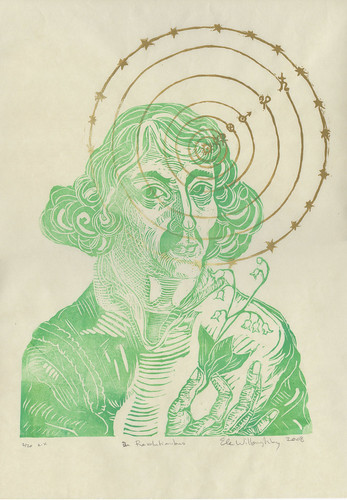 |
| De Revolutionibus, linocut, 2008, Ele Willoughby |
To celebrate his birthday, here is my portrait Copernicus (19 February 1473 – 24 May 1543) and his model of the celestial spheres, or as we would say, the solar system. Copernicus is shown in green with a lily of the valley, the standard Renaissance symbol to indicate a medical doctor, since like most proto-scientists, or 'philosophers' (doctors of philosophy) he learned his astronomy incidentally, since astrology was considered a vital diagnostic tool for medicine. His planetary model is shown as he conceived it in gold. Using the ancient Greek and Roman symbols, the heliocentric solar system has the following planets: Mercury (the fleet-footed messenger with his serpents and staff, the caduceus), Venus (goddess of beauty - the mirror, like an ankh), Earth (4 cardinal directions), Mars (spear and shield), Jupiter (thunderbolt) and Saturn (the scythe of Time). The outer planets had yet to be discovered. Beyond Saturn, he envisioned the sphere of the "fixed stars".
Copernicus' great work, "De revolutionibus orbium coelestium libri sex" (or "Six Books on the Revolutions of the Heavenly Spheres"), commonly known as "De Revolutionibus" (or "On the Revolutions") was finally approved for publication as he lay on his death bed. Was this due to perfectionism, fears, or religious belief and the concerns that displacing the Earth from the centre of the universe might conflict with literal interpretations of the Bible? Perhaps we will never know. But we do know that as a consequence of the publication of this provocative volume, the Western world experienced what is now known as the Copernican Revolution. This is a landmark in the history of science and culture.
The story of precisely how De Revolutionibus entered Western culture is told in Owen Gringrich's The Book Nobody Read (see sci & lit), which details the census he made of existing first and second editions of Copernicus' famous posthumous work, how he went about this and what he learned. There are at least 600 existing copies of the 1st and 2nd edition. There is plenty of evidence of enthusiastic readings, rapid transfer of information about interpretations, as well as negative reactions, amongst a Renaissance who's who. I learned several things from this book including a convincing argument that the "epicycles upon epicycles" story is a myth (one does not need circles upon circles to be added to the Ptolemaic geocentric planetary system model to predict "retrograde" motion) and contemporaries of Copernicus were often more excited about the details of the math and getting rid of the Ptolemaic equant than they were about the idea that we could live on a moving planet in a sun-centred solar system (bizarre to the modern reader)! Also interesting, is that Eames, of mid-century designer-chair fame (amongst other things), took many of the photographs in the book (The Book Nobody Read), having been hired to design IBM's display in honour of the 500 year anniversary of Copernicus' birth.






No comments:
Post a Comment